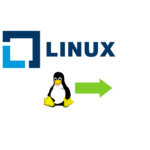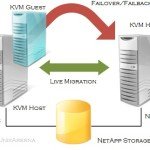How to extend / (root) filesystem without reinstalling the operating system ?. Is it possible to extend the root filesystem without destroying data? Is it possible to extend on the fly? The answer is yes if you are using LVM. This article will walk you through extending the root filesystem on Redhat Linux 8 (RHEL […]
Linux KVM
RHEL 7 – Pacemaker – Configuring HA KVM guest – Part 7
If you have followed the KVM article series in UnixArena , you might have read the article which talks about the KVM guest live migration. KVM supports the Guest Live migration (similar to VMware vMotion) but to provide high availability , you need need a cluster setup . (Like VMware HA). In this article ,we […]
Perform Live Migration on Linux KVM – Part 11
In KVM , you can migrate the running virtual machines from one KVM host to another without any downtime. Live migration works well if both the KVM hosts have access to the same storage pool. To make the storage pool accessible on both the KVM hosts, you need to use NFS or GFS2 filesystem(cluster filesystem). […]
Linux KVM – Change libvirt VM image store path – Part 10
In KVM , VM images are stored in /var/lib/libvirt/images directory by default. There might be the space limitation since /var filesystem lives under root-vg. In KVM virtualization, everyone would prefer to store VM images in central repository to migrate running VM from one hypervisor to another. In that case, you need to change the default path for the libvirt images […]
Linux KVM – How to add /Remove vCPU to Guest on fly ? Part 9
Does KVM support vCPU hot-plug ? Will Linux KVM guest can recognize the newly added vCPU’s ? The answer is “YES” off-course. Like KVM memory management, you can add/remove vCPU’s to active VM using “virsh” command. But this works if you have configured the KVM guest with Maximum vCPUs parameter. So while deploying the new […]
Linux KVM – How to add /Remove Memory to Guest on Fly ? Part 8
If the application/DB is demanding more Memory, you need to adjust the VM’s memory limit accordingly. KVM supports dynamic memory addition when you have configured the VM’s with Maximum memory limits. There are two parts to the VM configuration. 1. Maximum Limits 2. current allocation. At any point in time, you can’t exceed the maximum […]
Linux KVM – How to Add/Resize Virtual disk on fly? Part 7
In this article ,we will see that how to add new virtual disk or LUN to the KVM guest and how to resize the existing virtual disk on active domain/guest. This operations can be carried out on fly without any downtime to the guest operating system. KVM supports both physical LUN mapping and virtual disk […]
How to clone a KVM virtual Machines and reset the VM – Part 6
If you want to build several VMs with the same OS and configuration, “CLONE ” is the best method to save the time instead of installing operating system on each virtual machines. “virt-clone” is useful binary tool to clone the virtual machines with unique ID and MAC address (When you clone from existing virtual machine). To […]
KVM – Virtual Machine Manager Font issue – VMM GUI
Virtual Machine Manager (VMM or virt-Manager) is GUI tool to manage the KVM hypervisors. This tool can be installed on KVM hosts or in remote system to manage the VM’s. When I tired to access the virt-manager via SSH X11 forwarding on RHEL 7.2 , I got the GUI without any fonts (or with junk […]
Deploy KVM instance using Virt-Manger (VMM)- GUI – Part 5
Virt-Manager is powerful GUI tool to manage the multiple KVM hosts and it’s associated VM’s. It support’s XEN virtualization too. It can be installed on KVM hypervisor hosts or on centralized management host to manage the multiple hyper-visors from one place. Using virt-manager, you can start, pause(suspend), shutdown VMs, display VM details (Ex: VCPUs, memory, disk space), […]









